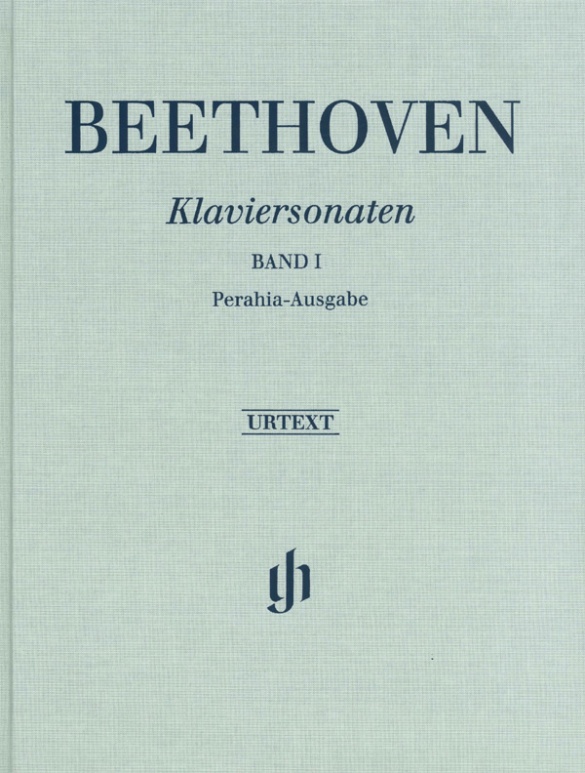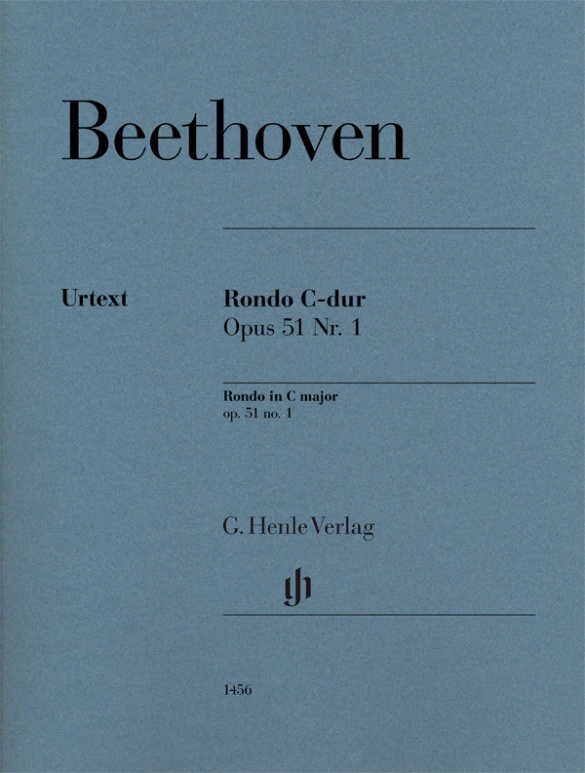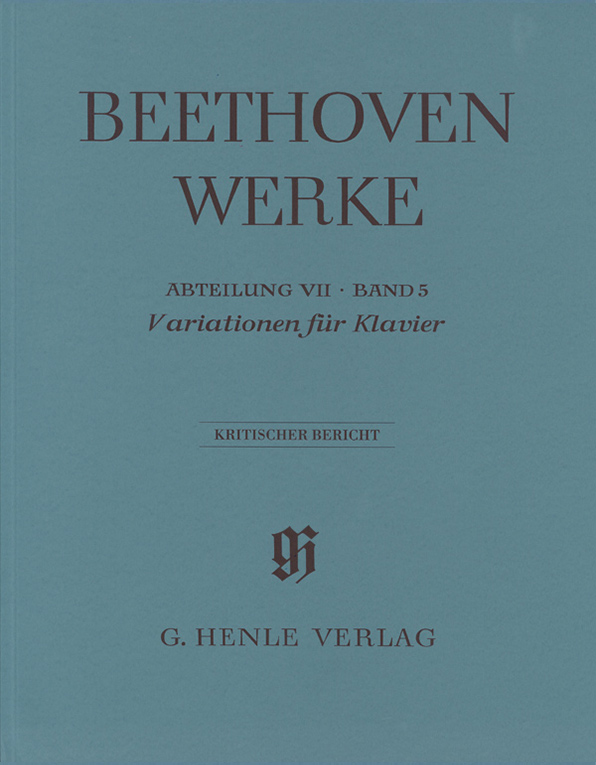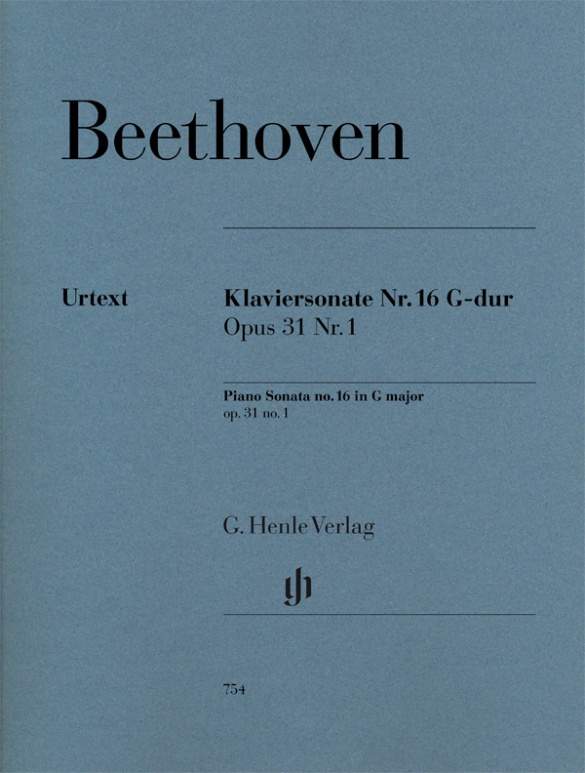

Ludwig van Beethoven
Piano Sonata no. 16 G major op. 31 no. 1
For half a century Henle’s edition of the Beethoven sonatas – the “New Testament” of the piano repertoire – has been universally recognized as the standard starting-point for any serious study of these works. Now, with the publication of the three op. 31 sonatas in revised separate editions, we are raising the yardstick another notch: no less a musician than the pianist and conductor Murray Perahia has agreed, for the first time ever, to publish his fingerings and, as co-editor, to confide his profound insights into the sources to music lovers everywhere. The musical text has been prepared in strict accordance with the rules of modern Urtext editing, and the volume is rounded off with a lengthy and informative preface and detailed notes on sources and alternative readings. To be continued …!
Content/Details
About the Composer
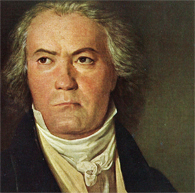
Ludwig van Beethoven
No composer has had as profound and sustained an influence on immediately following generations to the present day as Beethoven. His instrumental music, especially his symphonies, served as touchstones for symphonic composition throughout the nineteenth century. The extraordinarily high standard of his music and his relative independence as a freelance composer have led to his being characterized as the greatest composer of all time.
| 1770 | Baptized in Bonn on December 17, thus probably born on December 16, the son of Johann van Beethoven, a tenor in the court chapel of the prince-elector. First musical instruction from his father. |
| 1778 | First public performance. |
| around 1780 | Musical training with the deputy court organist Christian Gottlob Neefe, who in 1783 presented him in Cramer’s “Magazin der Musik” as a second Mozart. |
| 1782 | Acquaintance with the Breuning family, where his literary interest is aroused. First publication: Piano Variations in C minor on a March by Dressler, WoO 63. |
| 1783 | Harpsichordist in the court chapel; 1784 assistant to the court organist. |
| 1787 | Journey to Vienna. Here he very likely meets Mozart, who probably gives him some lessons. After a short while he must return home to his mother, who is ill with tuberculosis. |
| 1792 | He travels a second time to Vienna, where he will remain until the end of his life. Count von Waldstein sends him on his way with the famous words: “With steady diligence you will receive Mozart’s spirit from Haydn's hands.” In Vienna he studies with Haydn, Albrechtsberger, Schuppanzigh, and Salieri. As a pupil of Joseph Haydn, he achieves extraordinary recognition among the Viennese nobility and receives financial support. Great demand for his compositions from publishing houses: chamber music and piano sonatas from the Bonn and early Viennese years are issued. His first works printed in Vienna (among them the piano sonatas, Op. 2) already bear the hallmark of his compositional style: a forward-advancing, spirited, process-related character. |
| 1796 | Concert tours to Prague, Berlin, Leipzig, and Dresden, which cement his fame. |
| 1798 | Piano Sonata in C Minor, “Pathétique,” Op. 13. |
| 1798–1800 | String quartets, Op. 18. |
| 1799/1800 | Symphony No. 1 in C major, Op. 21 |
| 1795/1800 | Piano Concerto No. 1 in C major, Op. 15 |
| 1800–01 | Piano sonatas, Op. 27, “quasi una fantasia,” including the Moonlight Sonata, Op. 27 No. 2. |
| 1801 | Composition of the Symphony No. 2 in D major, Op. 36 (until 1802). Publication of the Piano Concerto No. 2 in B-flat major, Op. 19. |
| 1801/02 | Crisis brought on by incipient hearing loss, documented in the “Heiligenstadt Testament.” Thereafter he begins, by his own admission, a “New Path” in his compositions, reflected particularly in the piano sonatas, Op. 31 (including the Tempest Sonata); the piano variations, Op. 34 and 35; and the Symphony No. 3 in E-flat major, “Eroica,” Op. 55: they are characterized by enhanced structural development as well as by the use of Baroque techniques and models from other genres. |
| 1803–10/12 | Frenzy of creativity; these years are dubbed Beethoven’s “heroic period”. Written during this phase are Symphonies Nos. 3 through 8 (Opp. 55, 60, 67, 68, 92, 93); Piano Concerti Nos. 3 through 5 (Opp. 37, 58, 73); the Violin Concerto in D major, Op. 61; the Triple Concerto, Op. 56; string quartets (the Razumovsky quartets, Op. 59; the Harp Quartet in E-flat major, Op. 74; the String Quartet in F minor, “serioso,” Op. 95); piano trios (among them the “Ghost” Trio, Op. 70); piano sonatas (including the Waldstein Sonata in C major, Op. 53; the Appassionata in F minor, Op. 57; and “Les Adieux” in E-flat major, Op. 81a); songs (including “An die Hoffnung,” Op. 32); the Mass in C major (Op. 86); and the opera “Fidelio” (Op. 72, first version 1804/5). |
| 1808/09 | Beethoven rejects an offer to become the First Kapellmeister at the court in Kassel because his patrons, Archduke Rudolph, Prince Kinsky, and Prince Lobkowitz, provide him with a comparable yearly salary. |
| 1811/12 | Travels to the spa at Teplitz, where he meets Goethe. In 1812, the letter to the “immortal beloved,” whose identity (Antonie Brentano or Josephine Deym) is still uncertain. |
| 1814 | Piano Sonata in E minor, Op. 90; third version of the opera “Fidelio.” Extraordinarily successful concert with Symphonies Nos. 7 and 8. Still, financial crisis brought about by currency devaluation and the absence of yearly stipends from Kinsky and Lobkowitz. |
| 1815 | Death of his brother Caspar Carl and the beginning of the years-long battle for the guardianship of his nephew Karl. |
| 1816 | Song cycle “An die ferne Geliebte,” Op. 98; Piano Sonata in A major, Op. 101. |
| 1817–18 | Hammerklavier Sonata in B-flat major, Op. 106. |
| 1818 | Beethoven begins keeping conversation books due to increasing hearing loss. |
| 1819–23 | Missa solemnis, Op. 123. |
| 1819/23 | Diabelli Variations, Op. 120. |
| 1820 | Piano Sonata in E major, Op. 109, marks the beginning of his glorious late period, which is characterized by exceeding the boundaries of forms, by extreme pitch registers, advanced harmonies, and an increased penchant for contrapuntal forms such as fugue; standing in opposition to the propensity for esotericism in his chamber music is the monumentality of Symphony No. 9. |
| 1821/22 | Piano Sonatas in A-flat major, Op. 110 (with fugue in the final movement), and C minor, Op. 111 (reduction to two movements). |
| 1822–26 | String quartets, Opp. 127, 130, 131, 132, 135, as well as the Grosse Fuge, Op. 133, which originally formed the final movement of Op. 130. |
| 1823/24 | Completion of the Symphony No. 9 in D minor, Op. 125, which for the first time in the history of the genre includes voice parts (Schiller’s “Ode to Joy”). It will become the most famous and most frequently played symphony of all time. |
| 1827 | Death in Vienna on March 26. |
About the Authors
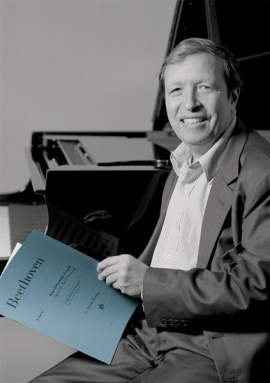
Murray Perahia (Fingering, Editor)

Norbert Gertsch (Editor)
Dr. Norbert Gertsch, born in 1967 in Rheinkamp/Moers, studied piano solo at the Mozarteum in Salzburg and read musicology and philosophy at the Paris Lodron University in Salzburg and the Ruperto Carola University Heidelberg on a scholarship from the “Studienstiftung des Deutschen Volkes”. In 1996 he wrote his doctoral thesis on Ludwig van Beethoven’s Missa solemnis (as part of the New Complete Edition) under Ludwig Finscher.
In the following year, he began to work at G. Henle Publishers, initially as an editor for electronic publishing. After working on a two-year project (1999–2000) sponsored by the German Research Foundation (DFG) preparing a new Beethoven Catalogue of Works, he became a scholarly editor at G. Henle Publishers. In 2003 he became Editor-in-Chief, in 2009 Deputy Managing Director and Head of Publishing. As of 1 January 2024, the Executive Board of the Günter Henle Foundation has appointed Dr. Norbert Gertsch, as the new managing director, succeeding Dr. Wolf-Dieter Seiffert.
Gertsch has published many Urtext editions for G. Henle Publishers, including volumes for a new edition of Beethoven’s Piano Sonatas together with Murray Perahia.
Product Safety Informations (GPSR)

G. Henle Verlag
Here you can find the information about the manufacturer of the product.G. Henle Verlag e.K.
Forstenrieder Allee 122
81476 München
Germany
info@henle.de
www.henle.com
Twenty years ago, in an article comparing all the available Beethoven piano sonata editions, I judged that the winner of the competition was Henle’s Wallner. Since then, little has surfaced in the way of sources and, barring the sudden appearance of autographs for the early sonatas (or the much-lamented ‘Hammerklavier’ autograph), new editions will be assessed more on judgement than discovery. Seen from this angle, Henle’s new Beethoven edition, though still in its infancy, gives every indication of giving players and scholars a great deal to learn from.
Nineteenth Century, 2006Es fascinate leer en el prólogo de esta edición crítica de la Sonata Opus 31,1, de Beethoven, la historia de las erratas de esta obra. Lo que sin duda desesperó a Beethoven hasta la furia es hoy una auténtica novela que desenredan cuidadosamente (hasta donde es posible) los editores, Norbert Gertsch y Murray Perahia.
Doce Notas, 2005De uitgave is een pronkstuk geworden: een uitgebreid en vemakelijk historisch voorwoord, een grondig kritisch commentaar en vingerzettingen van Murray Perahia.
Pianowereld, 2005Perahia’s edition also differs from the old Henle version because it prints both dashes and staccato dots and the layout is more spacious and user-friendly. With so many sources to choose from, editorial decision-making will always provoke controversy, but Perahia and co-editor Norbert Gertsch’s introductory notes present clear explanations behind their editorial choices … Strongly recommended.
International Piano, 2005recommendations
autogenerated_cross_selling
Further editions of this title
Further editions of this title


